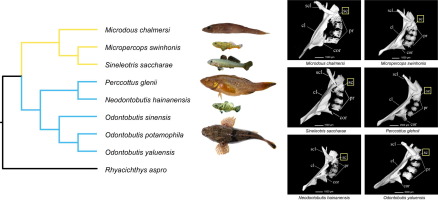Molecular Phylogenetics and Evolution ( IF 4.1 ) Pub Date : 2017-12-27 , DOI: 10.1016/j.ympev.2017.12.026 Hongjie Li , You He , Jiamei Jiang , Zhizhi Liu , Chenhong Li

|
The Odontobutidae is a group of freshwater sleepers endemic to East and Southeast Asia. The composition of the Odontobutidae is controversial and the systematics position of some species (e.g. Philypnus chalmersi) remains unknown. Phylogenetic relationship among the odontobutids has never been really tested due to the lack of informative morphological characters, and that molecular data have not been collected in many species. Here, we sampled 41 specimens, representing all known genera of the Odontobutidae except the Laotian genus Terateleotris, in addition to a disputable odontobutid species, Philypnus chalmersi and 14 outgroups (six families). We collected sequence data of 4434 single-copy nuclear coding loci using gene capture and Illumina sequencing. A robust phylogeny of the odontobutids and outgroups was built, confirming that the Odontobutidae is monophyletic and sister to the Rhyacichthyidae. We verified that Neodontobutis, Sineleotris and Philypnus chalmersi are members of the Odontobutidae based on the resulting phylogeny as well as patterns of pectoral girdle examined by X-ray microtomography. We proposed a new genus Microdous for Philypnus chalmersi based on the new morphological and molecular evidences. The family of the Odontobutidae can be divided into two clades: Microdous (=Philypnus) sister to a group consisting of Micropercops and Sineleotris, and Odontobutis sister to a group unifying Perccottus and Neodontobutis. Divergence time among the odontobutids was estimated based on 100 most clock-like loci and three fossil calibration points using BEAST. Ancestral range of the family was reconstructed using Reconstruct Ancestral States in Phylogenies (RASP) and BioGeoBEARS. The results suggest that the common ancestor of the odontobutids originated around 30.8 Ma (20.7–42.0 Ma, 95% HPDs) in South China. Orogeny, climatic change and river capture might account for diversification and current distribution of the odontobutids.

































 京公网安备 11010802027423号
京公网安备 11010802027423号